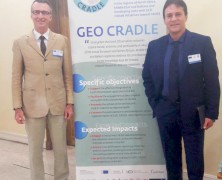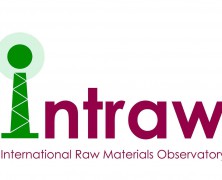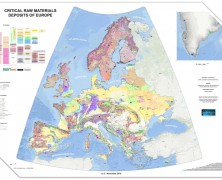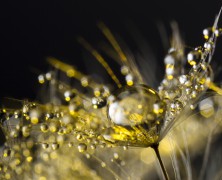Earth Observation tools applied to the raw materials sector in Africa can really make a difference New opportunities of collaborations for increasing the capacity building in Africa The 2nd EuroGeoSurveys Networking workshop titled “Aimed at in-situ network operators and Geological Surveys – especially in Middle East and North Africa (MENA)”, held in Timimoun, Algeria, last 19th-22nd October 2016 was a great success. Over 200 participants representing the whole Algerian geoscientific community, mainly from universities and government institutions at the highest levels attended, included heads and managers of all the main Algerian state-enterprises. Also Tunisia was represented at Director General level. In Algeria several sectors are not fully open to the free market, and the state-enterprises manage most of the country’s resources, including raw materials. The GEO-CRADLE partners presented several aspects of the project via different presentations in plenary session, raising a big deal of attention. Mr. Luca Demicheli, Secretary General of EuroGeoSurveys, during its introduction highlighted “The potential for growth in Algeria is impressive, and in such wide territories rich in mineral resources, yet still largely unexplored, Earth Observation tools applied to the raw materials sector can really make a difference”. The role of Geological Surveys and the importance of the raw materials topics in the framework of GEOSS and COPERNICUS has been also pointed out. Mr. Marek Graniczny, representative of the Polish Geological Institute, and Chair of the International Cooperation and Development Task Force, described the specific role of EuroGeoSurveys and of raw materials for reaching the goals of GEO-CRADLE. The Deputy Chair of the EGS Earth Observation and GeoHazards Expert Group, Ms. Veronika Kopackova, entered into the technical details of the benefit of applying novel Earth Observation technologies to the raw materials sector. While the importance of capacity building and of...
Earth Observation tools applied to the raw materials sector in Africa can really make a difference
posted by EuroGeoSurveys
EuroGeoSurveys at INSPIRE Conference 2016
posted by EuroGeoSurveys
The major event INSPIRE Conference was held in Barcelona on the 26th-30th September 2016. Introduced by Mr de Groof (European Commission DG for Environment), EuroGeoSurveys Secretary General Mr Luca Demicheli gave a remarkable talk on the European Geological Surveys contribution to INSPIRE, from One-Geology Europe to EGDI. “EGDI now is a reality in a new portal, where there is already a prototype perfectly functioning” “You can have access through a very simple system to information provided by the National Geological Surveys, all harmonized, INSPIRE-compliant, etc. It’s a fantastic tool” “We can state that now for the first time there is a home for pan-european geological datasets and services from past and ongoing projects. That will stay there forever, as we will maintain it” The INSPIRE Directive aims to create a European Union spatial data infrastructure for the purposes of EU environmental policies and policies or activities which may have an impact on the environment....
INTRAW PROJECT – SECOND JOINT PANELS OF EXPERTS WORKSHOP ON INTERNATIONAL RAW MATERIALS COOPERATION
posted by EuroGeoSurveys
EuroGeoSurveys Secretary General Mr Luca Demicheli attended the INTRAW Project Workshop in Cornwall (UK) from 5 to 7 October 2016, as part of the high-level Panel of Experts on international Raw materials cooperation. The panel of Experts provides the project consortium with suggestions on how to enhance the European Union’s International Observatory for Raw Materials that will be launched by the end of the project’s lifetime. The INTRAW (International Raw Materials Observatory) Project is coordinated by the European Federation of Geologists (EFG) and brings together an international consortium of 15 partners from 9 European countries, Australia, South Africa and the USA. [To know more about INTRAW and the Workshop outcomes read the full press release...
New map of critical Raw Materials in Europe
posted by EuroGeoSurveys
A new map showing the occurrences of critical raw materials in Europe has been released by the Minerals Resources Expert Group of EuroGeoSurveys. In particular, the Document shows European mineral deposits from the ProMine Mineral Deposit database as containing critical commodities, according to the list of critical raw materials of the European Commission. Europe’s industry and economy depends on a secure and good access to many commodities. In 2010, the European Commission identified 14 critical non energy non-agricultural raw materials. Criticality is based on both the scarcity of supply and the importance of the material to European industry. The list has been updated and expanded over time. Today, it includes the following critical materials: antimony, beryllium, boron, fluorspar, phosphate, gallium, germanium, graphite, indium, silicon, cobalt, coke, chrome magnesite, magnesium, niobium, platinum group metals, light and heavy rare earth elements and tungsten. Such list is deemed strategically important for many product areas, not least in environmental technology. Download the PDF of the Map More information about the Map: ...
“WONDER WATER- THE VALUE OF WATER”, A GEOLOGICAL JOURNEY AROUND EUROPE’S MINERAL SPRINGS, SPAs AND THERMAL BATHS
posted by EuroGeoSurveys
“WONDER WATER- THE VALUE OF WATER” A GEOLOGICAL JOURNEY AROUND EUROPE’S MINERAL SPRINGS, SPAs AND THERMAL BATHS Brussels, 10 March 2016 The latest EuroGeoSurveys publication “Wonder Water – the Value of Water” will be launched on the 15th March 2016 at 16.00 o’clock, at the Scotland House of Brussels, during the EuroGeoSurveys 40th General Meeting. The book brings you on a fantastic geological journey around Europe through mineral springs, thermal baths, SPAs, pools, etc. Are you ready to explore fantastic places and discover the health benefits of groundwater on which geology has a mayor impact? For instance, at the Clémentine spring of Spa in Belgium, calcium-bicarbonate water, once ingested, purifies the liver and facilitates digestion. Alkaline springs such the one of Troodos, Cyprus, are thought to have beneficial effects on healing rheumatic and skin diseases. Bath of sulphuric waters, such as at the Latvian health resort of Jaunķemeri, increase body tone, improve circulation of blood and metabolism. All these water’s properties are connected with particular geological situations (terrains, rock types, climate, etc.), reflecting a wide geological diversity across Europe. Special attention is given to myths and stories. In Finnish mythology, vedenväki (‘water folk’) were water spirits, nymphs, etc. said to dwell in lakes, rivers, rapids, the sea and even springs and wells. And how not to be fascinated with the Greek myth of Pyra and Defkelionas? To gain many and strong children they had a bath in the warm spring waters of Edipsos, and thus acquired Hellin, father of all the Hellenic tribes. Through “Wonder Water” EuroGeoSurveys renewed its commitments in engaging with the wider public to communicate geology by showing how our groundwater, essential in our daily life, is used and enjoyed. Indeed, it has been estimated that 75% of European Union...





